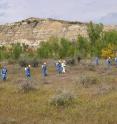Research reveals widespread herbicide use on North American wildlands
University of Montana researchers are giving the public its first look at the widespread use of herbicides on federal and tribal land in North America, and they urge land managers to better document it. Herbicides originally were developed to suppress weeds in crop agriculture. Today, they also are widely used in natural areas or "wildlands" to control non-native plants, which have arrived from other regions and can cause considerable ecological and economic harm.
While the magnitude of herbicide usage is well-documented for croplands, this new study is the first to reveal the amount of herbicides sprayed on wildlands.
UM researchers Viktoria Wagner and Cara Nelson, along with ecologists Pedro Antunes of Algoma University and Michael Irvine of Ontario Ministry of Natural Resources, discovered that more than 1.2 million acres of U.S. federal and tribal wildlands were sprayed with about 200 tons of herbicide in 2010.
"The numbers are much less than those for croplands, but they are astonishing," said Wagner, a former UM postdoctoral researcher who led the study. "Imagine: The wildland area sprayed by herbicides in that year is comparable to 930,630 football fields, and the amount of herbicides used equals the weight of 13 school buses."
Wagner said this amount is a conservative estimate, however, because data were not available for U.S. Forest Service land. The researchers used a survey to reach governmental offices and agro-statistical companies in the U.S., Canada and Mexico.
"It involved a lot of emails and phone calls to get the data we wanted," Wagner said, "but the effort was worthwhile."
The study also exposed that glyphosate ranked as one of the most commonly used active ingredients.
"This finding was unexpected because glyphosate is a nonselective herbicide that harms grasses and herbs alike and thus has a higher potential to negatively affect desired native plants," Wagner said.
The researchers link glyphosate's wide popularity to its chemical properties, low price and low usage restrictions. Nelson, an associate professor in UM's Department of Ecosystem and Conservation Science, said information about herbicide usage is critical for effective wildand management, and that study results indicate the need to improve methods of monitoring its use and effects.
"Well-designed studies on the efficacy and effects of herbicides on native plant communities, coupled with increased reporting of herbicide usage, would assist with developing best practices for effectively and safely using herbicides to manage non-native plants in wildlands," Nelson said.
Source: The University of Montana
Other sources
- Research reveals widespread herbicide use on North American wildlandsfrom PhysorgWed, 29 Jun 2016, 20:41:04 UTC
- Herbicides used widely on federal, tribal wildlands, study saysfrom UPIWed, 29 Jun 2016, 20:21:14 UTC
- Research reveals widespread herbicide use on North American wildlandsfrom Science DailyWed, 29 Jun 2016, 19:21:06 UTC
